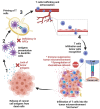Lighting Up the Fire in the Microenvironment of Cold Tumors: A Major Challenge to Improve Cancer Immunotherapy
- PMID: 37443821
- PMCID: PMC10341162
- DOI: 10.3390/cells12131787
Lighting Up the Fire in the Microenvironment of Cold Tumors: A Major Challenge to Improve Cancer Immunotherapy
Abstract
Immunotherapy includes immune checkpoint inhibitors (ICI) such as antibodies targeting cytotoxic T-lymphocyte-associated protein 4 (CTLA-4) or the programmed cell death protein/programmed death ligand 1 (PD-1/PD-L1) axis. Experimental and clinical evidence show that immunotherapy based on immune checkpoint inhibitors (ICI) provides long-term survival benefits to cancer patients in whom other conventional therapies have failed. However, only a minority of patients show high clinical benefits via the use of ICI alone. One of the major factors limiting the clinical benefits to ICI can be attributed to the lack of immune cell infiltration within the tumor microenvironment. Such tumors are classified as "cold/warm" or an immune "desert"; those displaying significant infiltration are considered "hot" or inflamed. This review will provide a brief summary of different tumor properties contributing to the establishment of cold tumors and describe major strategies that could reprogram non-inflamed cold tumors into inflamed hot tumors. More particularly, we will describe how targeting hypoxia can induce metabolic reprogramming that results in improving and extending the benefit of ICI.
Keywords: hypoxia; immune checkpoint inhibitors; immunotherapy; metabolic reprogramming; tumor microenvironment.
Conflict of interest statement
The authors declare no conflict of interest.
Figures



Similar articles
-
Immunologic tumor microenvironment modulators for turning cold tumors hot.Cancer Commun (Lond). 2024 May;44(5):521-553. doi: 10.1002/cac2.12539. Epub 2024 Mar 29. Cancer Commun (Lond). 2024. PMID: 38551889 Free PMC article. Review.
-
Defects in the necroptosis machinery are a cancer resistance mechanism to checkpoint inhibitor immunotherapy.J Immunother Cancer. 2025 May 8;13(5):e010433. doi: 10.1136/jitc-2024-010433. J Immunother Cancer. 2025. PMID: 40345706 Free PMC article.
-
Multi-Omics Perspective Reveals the Different Patterns of Tumor Immune Microenvironment Based on Programmed Death Ligand 1 (PD-L1) Expression and Predictor of Responses to Immune Checkpoint Blockade across Pan-Cancer.Int J Mol Sci. 2021 May 13;22(10):5158. doi: 10.3390/ijms22105158. Int J Mol Sci. 2021. PMID: 34068143 Free PMC article.
-
The efficacy of PD-1/PD-L1 blockade in cold cancers and future perspectives.Clin Immunol. 2021 May;226:108707. doi: 10.1016/j.clim.2021.108707. Epub 2021 Mar 1. Clin Immunol. 2021. PMID: 33662590 Review.
-
Reinstating immunogenicity using bispecific anti-checkpoint/agent inhibitors.Biomed Pharmacother. 2023 Jun;162:114621. doi: 10.1016/j.biopha.2023.114621. Epub 2023 Mar 31. Biomed Pharmacother. 2023. PMID: 37004328 Review.
Cited by
-
Monoclonal antibody immune therapy response instrument for stratification and cost-effective personalized approaches in 3PM-guided pan cancer management.EPMA J. 2025 Mar 22;16(2):465-503. doi: 10.1007/s13167-025-00403-w. eCollection 2025 Jun. EPMA J. 2025. PMID: 40438490 Review.
-
Nanoimmunotherapy: the smart trooper for cancer therapy.Explor Target Antitumor Ther. 2025 Apr 10;6:1002308. doi: 10.37349/etat.2025.1002308. eCollection 2025. Explor Target Antitumor Ther. 2025. PMID: 40230883 Free PMC article. Review.
-
The future of affordable cancer immunotherapy.Front Immunol. 2023 Sep 6;14:1248867. doi: 10.3389/fimmu.2023.1248867. eCollection 2023. Front Immunol. 2023. PMID: 37736099 Free PMC article. Review.
-
Experimental models for developing oncolytic virotherapy for metastatic prostate cancer.Front Immunol. 2025 Jul 10;16:1626432. doi: 10.3389/fimmu.2025.1626432. eCollection 2025. Front Immunol. 2025. PMID: 40709190 Free PMC article. Review.
-
Signature Gene Mutations in Colorectal Cancer: Potential Neoantigens for Cancer Vaccines.Int J Mol Sci. 2025 May 9;26(10):4559. doi: 10.3390/ijms26104559. Int J Mol Sci. 2025. PMID: 40429703 Free PMC article. Review.
References
Publication types
MeSH terms
Substances
Grants and funding
- 7.4559.21 IMPACT21 and 7.4560.21 INCITE21/FNRS Televie
- 2023/Roche Pharma
- INCOM BIOM/RCMS foundation
- BRIDGES2020/BM/15412275/SMART-COMBO; BRIDGES2021/BM/16358198/TRICK-ALDH; INTER/EUROSTARS21/16896480/C2I; INTER/EUROSTARS21/16896735/PreCyse/Luxembourg National Research Fund
- 2019/Kriibskrank Kanner Foundation
LinkOut - more resources
Full Text Sources
Medical
Research Materials

